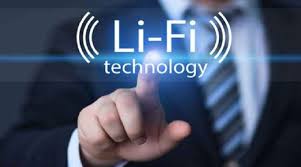This OWC technology uses light from LED's as a medium to deliver networked, mobile, high-speed communication in a similar manner to wi-fi. The Li-Fi market is projected to have a compound annual growth rate of 82% from 2013 to 2018 and to be worth over $6 billion per year by 2018. Visible light communications (VLC) works by switching the current to the LEDs off and on at a very high rate,too quick to be noticed by the human eye. Although Li-Fi LED's would have to be kept on to transmit data, they could be dimmed to below human visibility while still emitting enough light to carry data.The light waves cannot penetrate walls which makes a much shorter range, though more secure from hacking, relative to Wi-Fi. Direct line of sight is not necessary for Li-Fi to transmit a signal; light reflected off the walls can achieve 70 Mbit/s .
Li-Fi
has the advantage of being useful in electromagnetic sensitive areas such as in
aircraft cabins, hospitals and nuclear power plants without causing
electromagnetic interference. Both Wi-Fi and Li-Fi transmit data over the electromagnetic
spectrum, but whereas Wi-Fi utilizes radio waves, Li-Fi uses visible light.
While the US Federal Communications Commission has warned of a potential
spectrum crisis because Wi-Fi is close to full capacity, Li-Fi has almost no
limitations on capacity'.
The visible light spectrum is 10,000 times larger than the entire radio frequency spectrum.Researchers have reached data rates of over 10 Gbit/s, which is much faster than typical fast broadband in 2013.Li-Fi is expected to be ten times cheaper than Wi-Fi. Short range, low reliability and high installation costs are the potential downsides.
Pure LiFi demonstrated the first commercially available Li-Fi system, the Li-1st, at the 2014 mobile world congress in Barcelona. Bg-Fi is a Li-Fi system consisting of an application for a mobile device, and a simple consumer product, like an device, with color sensor, microcontroller, and embedded software. Light from the mobile device display communicates to the color sensor on the consumer product, which converts the light into digital information. Light emitting diodes enable the consumer product to communicate synchronously with the mobile device.
The visible light spectrum is 10,000 times larger than the entire radio frequency spectrum.Researchers have reached data rates of over 10 Gbit/s, which is much faster than typical fast broadband in 2013.Li-Fi is expected to be ten times cheaper than Wi-Fi. Short range, low reliability and high installation costs are the potential downsides.
Pure LiFi demonstrated the first commercially available Li-Fi system, the Li-1st, at the 2014 mobile world congress in Barcelona. Bg-Fi is a Li-Fi system consisting of an application for a mobile device, and a simple consumer product, like an device, with color sensor, microcontroller, and embedded software. Light from the mobile device display communicates to the color sensor on the consumer product, which converts the light into digital information. Light emitting diodes enable the consumer product to communicate synchronously with the mobile device.


No comments:
Post a Comment